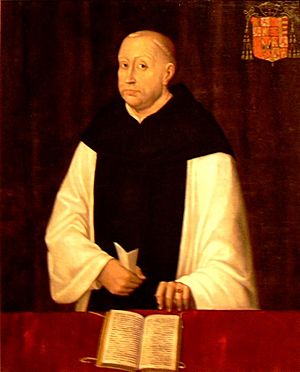Hernando de Aragón facts for kids
Quick facts for kids Hernando de Aragón |
|
|---|---|
| Archbishop of Zaragoza | |

Aragón in a Cistercian habit, attributed to Roland de Mois
|
|
| Archdiocese | Roman Catholic Archdiocese of Zaragoza |
| Appointed | 21 May 1539 |
| Reign ended | 29 January 1575 |
| Predecessor | Fadrique de Portugal |
| Successor | Bernardo de Fresneda |
| Orders | |
| Consecration | 9 November 1539 |
| Personal details | |
| Born | 25 July 1498 Zaragoza, Aragón |
| Died | 29 January 1575 (aged 76) |
| Parents | Alonso, Archbishop of Zaragoza Ana de Gurrea |
| Children | Pedro, Lord of Ballobar |
Hernando de Aragón y de Gurrea (born July 25, 1498 – died January 29, 1575) was a very important person in the history of Aragon, a region in Spain. He was a Cistercian monk, the Archbishop of Zaragoza, and also served as the Lieutenant General of Aragon. This meant he was like the king's main representative in the region. He was also a historian and loved art.
Contents
His Family and Early Life
Hernando was born in Zaragoza, a city in Aragon. He was the second son of Alonso de Aragón, who was also the Archbishop of Zaragoza. Later, his father became the Archbishop of Valencia. Hernando's father was an illegitimate son of King Ferdinand II of Aragon. This made Hernando a first-half cousin to famous rulers like Charles V, Holy Roman Emperor and Mary I of England.
Hernando had one son named Pedro, Lord of Ballobar. His mother was María Jiménez Cerdán.
Becoming a Church Leader
Even though some expected Hernando to become a soldier, he chose a life in the church. He joined the Cistercian order at the Monastery of Piedra. He became a priest in 1524.
His cousin, King Charles I of Aragon, made him the Abbot of Veruela Abbey. An abbot is the head of a monastery. On May 21, 1539, King Charles I appointed him as the Archbishop of Zaragoza. This was a special position because his father and older brother had held it before him. He officially became archbishop on November 9, 1539.
King Charles I also made him his deputy in the Aragonese Cortes in 1524. The Cortes was like a parliament or assembly for Aragon. Later, King Philip II, Charles's son, made Hernando the Lieutenant General of Aragon in 1566. This was a very powerful role, overseeing the region for the king.
A Supporter of Arts and History
Hernando de Aragón was a big supporter of art and culture in Aragon. He especially cared about La Seo Cathedral in Zaragoza. He paid for two chapels to be built there. He wanted to be buried in one of these chapels with his mother.
He also had the idea to build Lonja de Zaragoza, a famous building in Zaragoza that was once a trading hall. He also ordered the building of the Charterhouse of Aula Dei, a monastery.
Besides his church and government duties, Hernando was also the Official Chronicler of Aragon. This meant he wrote down the history of the region. He wrote a book called "History of the Kings of Aragon" (in Spanish: Historia de los Reyes de Aragón).
He was buried in La Seo Cathedral, just as he wished, alongside his mother.
See also
 In Spanish: Hernando de Aragón para niños
In Spanish: Hernando de Aragón para niños

